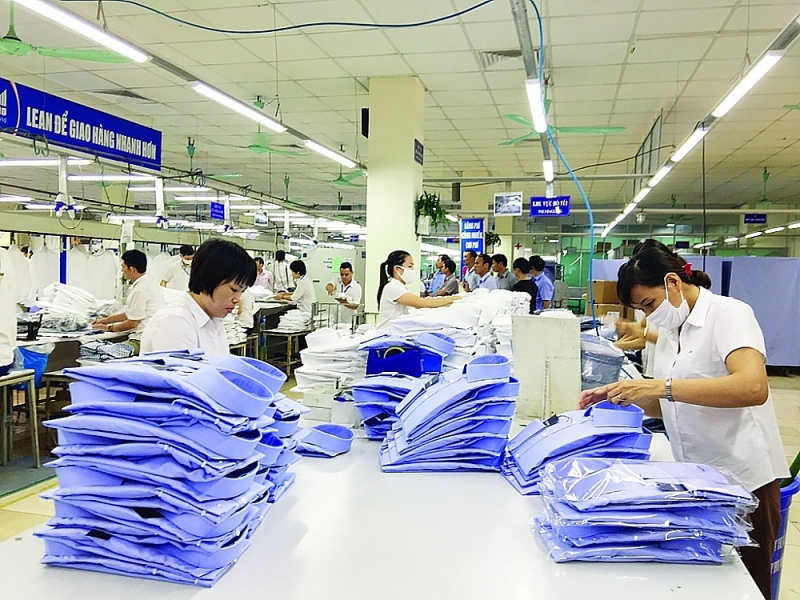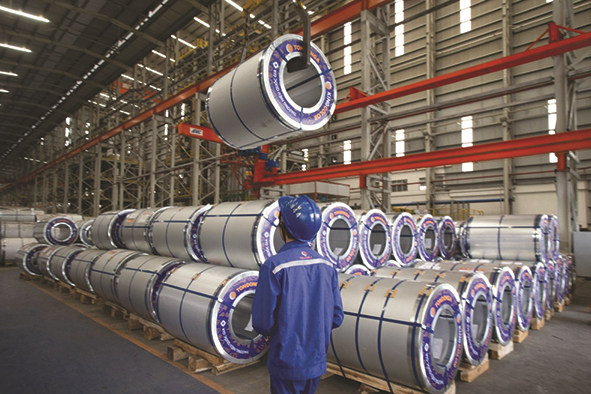Breakthrough materials industry development to avoid importing everything
 |
| The textile and garment industry is a typical industry that depends on imported raw materials, with the import rate of nearly 90% fabric and 80% of yarn. Photo: Nguyen Thanh |
Import 90% of production materials
According to the latest data from the General Statistics Office (Ministry of Planning and Investment), in the first 11 months of 2020, the import turnover of goods is estimated at US$234.5 billion, up 1.5% over the same period last year. Notably, in terms of the structure of imported goods from the beginning of the year to the end of November 2020, the group of materials for production was estimated at US$218.8 billion, up 1.6% over the same period last year and accounting for 93.3% of total import turnover; consumer goods were estimated at US$15.7 billion, up 0.5% and accounting for 6.7%.
In 2019 and many previous years, the picture of Vietnam's imports of goods did not change much when the proportion of materials for production was always overwhelming. Specifically, in 2019, Vietnam imported US$253.51 billion, up 7% compared to 2018. Of which, the group of materials for production was estimated at US$231.2 billion, up 6.7% over the previous year and accounting for 91.2% of total import turnover; consumer goods were estimated at US$22.3 billion, up 10.8% and accounting for 8.8%.
Data from the Ministry of Industry and Trade shows that, in general, Vietnam's material industry production capacity is still small, while productivity and quality are limited. The localization rate of production of materials serving the manufacturing industry is low, such as that of cast iron (below 30%); aluminum materials, copper materials (about 5%); chemicals for the plastic and rubber industry still have to import 70%; materials for the textile and garment industry have to import nearly 90% of fabrics and 80% of fibers.
According to the Ministry of Industry and Trade, one of the "bottlenecks" slowing down the process of industrialization and modernization is the materials manufacturing industries in Vietnam have not met the demand for domestic production and export markets. This leads to imports with an excessive proportion of industrial materials from abroad, causing the cost of industrial products of Vietnam to increase and competitiveness to drop. Domestic production lacks autonomy and depends greatly on value chains abroad. The ministry also said that the failure of the supply chain of imported raw materials for domestic production in the context of the impact of pandemic, which has severely affected domestic industries,is the best evidence for this phenomenon.
According to Mr. Cao DucPhat, Deputy Head of Central Economic Department, said:“Developing the materials industry is a big problem for all countries, especially for a country that is promoting the process of industrialization and modernization, an increasingly integrated international economy. We cannot import most of the input materials for industry, agriculture and other economic sectors. Thus, the cost of Vietnam's products will be higher than the other competition or will turn the country into an outsourcing country.
Promote the materials industry
To build an efficient, autonomous and competitive economy, raw materials must be maximized, but they must be equal or better in quality, as well as cheaper than importing, Mr. Cao DucPhat said. In order to achieve that, science and technology must lead the way, but there needs be proper organization.
“Vietnam has rich resources, but resources must be exploited properly. Science and technology should focus on research and development of materials on the basis of promoting available resources. Vietnam has huge reserves of bauxite, tungsten, titanium,but must find more efficient mining and processing technologies to promote and enrich the country. Vietnam does not have advantages to grow cotton, but the textile and garment industry still has a competitive advantage when labor costs are still cheap, despite having to import raw materials. In the long term, the advantage of cheap labor will fade. The industry needs to find alternative raw materials to compete from the rich resources of the tropical country,” Mr. Cao DucPhat said.
Regarding scientific research and technology development in the field of materials, Dr. Nguyen DinhHau, Director of the Department of Science and Technology of the Ministry of Science and Technology,said the resulting edge still has some shortcomings and limitations. Typically, most of the research results are only used on a small scale, failing to meet the needs of large-scale production enterprises, especially multinational enterprises that play a leading role in the market. In addition, some companies producing materials have not focused on investing in technology research and innovation. Many research products still face difficulties in product application and development.
“The Party and State need to issue the National Strategy for the development of the material industry until 2030, with a vision to 2045. This will be a guideline and a basis for completing mechanisms and policies for the materials industry development. At the same time, it is necessary to develop science and technology in general, science and technology in the field of materials in particular, considering this a key stage to develop the material industry; supporting the formation of a pioneer enterprise in material production,” said Mr. Nguyen Dinh Hau.
Agreeing that the State needs to invest more in science and technology, including science and technology in the material industry, some experts believe that it is necessary to discuss mechanisms and policies for state resources to be used effectively and have a mechanism to develop and promote high capacity of the contingent of scientists in research institutes, and at the same time create conditions for the whole society, first of all, and the community of businesses. That creates sustainable national growth.
Related News

Customs strictly controls tax evasion tricks in steel imports
09:22 | 25/11/2024 Anti-Smuggling
Latest News

Foreign investors flock to invest in southern provinces and cities
15:20 | 25/11/2024 Import-Export

New step in tracing seafood origin, meeting export requirements
09:21 | 25/11/2024 Import-Export

Việt Nam's pangasius exports expected to reach $2b in 2024
18:20 | 24/11/2024 Import-Export

VN’s first pharmaceutical industrial park to be built
18:10 | 24/11/2024 Import-Export
More News

Accelerating investment to meet "green" standards
09:02 | 24/11/2024 Import-Export

US initiates investigation into pharmaceutical capsule shells imported from Việt Nam
17:50 | 23/11/2024 Import-Export

UKVFTA gives advantages to Vietnamese fishery products in the UK, urging focus on quality for further expansion
17:47 | 23/11/2024 Import-Export

Agricultural, forestry and fishery trade surplus value shoots up
10:54 | 23/11/2024 Import-Export

New export and business cooperation opportunities from "dual conversion"
10:53 | 23/11/2024 Import-Export

VN's food processing industry struggles to improve quality and value chain integration
15:53 | 22/11/2024 Import-Export

Approach strategy of the seafood industry when implementing UKVFTA
09:26 | 22/11/2024 Import-Export

Mid-November: Vietnam's trade volume matches 2023 total, eyes record-breaking growth
09:25 | 22/11/2024 Import-Export

Vietnamese enterprises facing challenges from cross-border e-commerce platforms
14:32 | 21/11/2024 Import-Export
Your care

Foreign investors flock to invest in southern provinces and cities
15:20 | 25/11/2024 Import-Export

New step in tracing seafood origin, meeting export requirements
09:21 | 25/11/2024 Import-Export

Việt Nam's pangasius exports expected to reach $2b in 2024
18:20 | 24/11/2024 Import-Export

VN’s first pharmaceutical industrial park to be built
18:10 | 24/11/2024 Import-Export

Accelerating investment to meet "green" standards
09:02 | 24/11/2024 Import-Export





